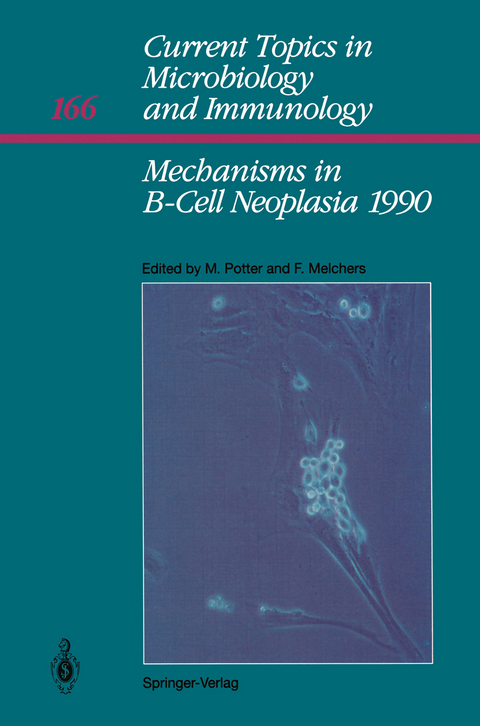
Mechanisms in B-Cell Neoplasia 1990
Springer Berlin (Verlag)
978-3-642-75891-1 (ISBN)
Michael Potter is Reader in the Philosophy of Mathematics at Cambridge University. He is the author of Sets (OUP, 1990), Reason's Nearest Kin (OUP, 2000), Set Theory and its Philosophy (OUP, 2004), and Mathematical Knowledge (edited with Mary Leng and Alexander Paseau, OUP, 2007).
IL-6 in Multiple Myeloma.- IL-6 as a Growth Factor for Human Multiple Myeloma Cells -A Short Overview.- Interleukin 6 (IL-6) and Its Receptor (IL-6R) in Myeloma/Plasmacytoma. With 7 Figures.- Interleukin-6 is a Major Myeloma Cell Growth Factor In Vitro and In Vivo Especially in Patients with Terminal Disease. With 4 Figures.- Macrophages as an Important Source of Paracrine IL6 in Myeloma Bone Marrow. With 1 Figure.- Retroviral-Mediated Transfer of Interleukin-6 Into Hematopoietic Cells of Mice Results in a Syndrome Resembling Castleman's Disease. With 3 Figures.- A Monoclonal Antibody Specific for the Murine IL-6-Receptor Inhibits the Growth of a Mouse Plasmacytoma In Vivo. With 3 Figures.- Production of IL-2 in CD25 Positive Malignant Lymphomas.- IL-6 Induces Hybridoma Cell Growth Through a Novel Signalling Pathway. With 4 Figures.- Selective Killing of IL6 Receptor Bearing Myeloma Cells Using Recombinant IL6-Pseudomonas Toxin. With 2 Figures.- In Vitro Culture of a Primary Plasmacytoma that has Retained Its Dependence on Pristane Conditioned Microenvironment for Growth. With 1 Figure.- Experimental Plasmacytomas and B-Cell Tumors.- Modulation of Growth and Differentiation of Murine Myeloma Cells by Immunoglobulin Binding Factors. With 3 Figures.- A New Cell Adhesion Mechanism Involving Hyaluronate and CD44. With 1 Figure.- The Activity of an ABL-MYC Retrovirus in Fibroblast Cell Lines and in Lymphocytes. With 3 Figure.- Plasmacytoma Induction in BALB/c6;15 ? DBA/2 Chimeras.With 4 figures.- Mouse Plasmacytoma Associated (MPC) T(15;16) Translocation Occurs Repeatedly in New MPC Induction System. With 8 Figures.- A Retrovirus Expressing v-abl and c-myc Induces Plasmacytomas in 100% of Adult Pristane-PrimedBALB/c Mice. With 3 Figures.- Role of raf-1 Protein Kinase inIL-3 and GM-CSF-Mediated Signal Transduction.- Identification of Consensus Genes Expressed in Plasmacytomas but Not B Lymphomas. With 2 Figures.- Proliferation of B Cell Precursors in Bone Marrow of Pristane-Conditioned and Malaria-Infected Mice: Implications for B Cell Oncogenesis.- The Human CBLOncogene. With 5 Figures.- LymphoidTumorigenesis by v-abl and BCR-v-abl in Transgenic Mice. With 5 Figures.- Abnormalities of the Immune System Induced by Dysregulated bcl-2 Expression in Transgenic Mice. With 3 Figures.- Growth Regulation to B- Cells : Immortalization.- Immortalization of Primary Murine B Lymphocytes with Oncogene-ContainingRetroviral Vectors. With 2 Figures.- Functionality of Clonal Lymphoid Progenitor Cells Expressing the P210 BCR/ABL Oncogene. With 2 Figures.- Constitutive and Cell Cycle Regulated Expression of c-myc mRNA is Related to the State of Differentiation in Murine B-Lymphoid Tumors. With 3 Figures.- Bcl-2: B Cell Life, Death and Neoplasia.- C-myc Genes in B- Cell Neoplasia.- Binding of NF-KB-like Factors to Regulatory Sequences of the c-myc Gene. With 6 Figures.- Tumorigenesis in Transgenic Mice Expressing the c-mycOncogem with Various Lymphoid Enhancer Elements. With 8 Figures.- Isolation of Normal and Tumor-Specific Pvt-1 cDNA Clones. With 3 Figures.- Expression of c-myc and Pvt-1. With 4 Figures.- Mutational Analysis of the Carboxy-Terminal Casein Kinase II Phosphorylation Site in Human c-myc. With 2 Figures.- The Transforming Activity of PP59C-MYC is Weaker than that of v-myc. With 2 Figures.- Recombination of the c-myc Gene with IgH Enhancer-Sµ Sequences in a Murine Plasmacytoma (DCPC 21) Without Visible Chromosomal Translocations. With 9 Figures.- Downstream Regulatory Elements in the c-myc Gene. With 2 Figures.- DNA Repair in the c-mycLocus. With 2 Figures.- Mechanism of Negative Feed-back Regulation of c-myc Gene Expression in B-Cells and its Inactivation in Tumor Cells. With 5 Figures.- Moloney Murine Leukemia Virus Integration 1060 Base Pairs 5? of c-myc Exon 1 in a Plasmacytoma Without a Chromosomal Translocation. With 2 Figures.- Role of EBV in B-Cell Neoplasia.- Cell Phenotype Dependent Down-regulation of MHC Class I Antigens in Burkitt's Lymphoma Cells. With 3 Figures.- EBV-Associated B-Cell Lymphomas Following Transfer of Human Peripheral Blood Lymphocytes to Mice with Severe Combined Immune Deficiency With 3 Figures.- Analysis of Epstein-Barr Virus Gene Expression in Lymphomas Derived from Normal Human B Cells Grafted into SCID Mice. With 4 Figures.- Deregulated c-mycGene Expression and Persistence of EBV are Not Sufficient to Maintain the Malignant Phenotype in Burkitt's Lymphoma x B-Lymphoblastoid Hybrid Cells. With 2 Figures.- Epstein-Barr Virus Latency and Activation in Vivo. With 2 Figures.- Relative Predispositional Effect of a PADPRP Marker Allele in B-Cell and Some Non B-Cell Malignancies. With 4 Figures.- Epstein-Barr Virus Terminal Protein Gene Transcription is Dependent on EBNA 2 Expression and Provides Evidence for Viral Integration into the Host Genome. With 6 Figures.- Genomic Integration as a Novel Mechanism of EBV Persistence. With 2 Figures.- Effect of TGF-beta on the Proliferation of B Cell Lines and on the Immortalisation of B Cells by EBV.
| Erscheint lt. Verlag | 19.1.2012 |
|---|---|
| Reihe/Serie | Current Topics in Microbiology and Immunology |
| Zusatzinfo | XIX, 380 p. |
| Verlagsort | Berlin |
| Sprache | englisch |
| Maße | 155 x 235 mm |
| Gewicht | 609 g |
| Themenwelt | Medizin / Pharmazie ► Medizinische Fachgebiete ► Dermatologie |
| Medizin / Pharmazie ► Medizinische Fachgebiete ► Mikrobiologie / Infektologie / Reisemedizin | |
| Medizin / Pharmazie ► Medizinische Fachgebiete ► Onkologie | |
| Studium ► Querschnittsbereiche ► Infektiologie / Immunologie | |
| Schlagworte | Burkitt's lymphoma • Lymphome • Myelome • Neoplasie • Oncology • Onkologie • plasma cells • Tumoren • Tumorigenesis • Tumors |
| ISBN-10 | 3-642-75891-6 / 3642758916 |
| ISBN-13 | 978-3-642-75891-1 / 9783642758911 |
| Zustand | Neuware |
| Haben Sie eine Frage zum Produkt? |
aus dem Bereich


